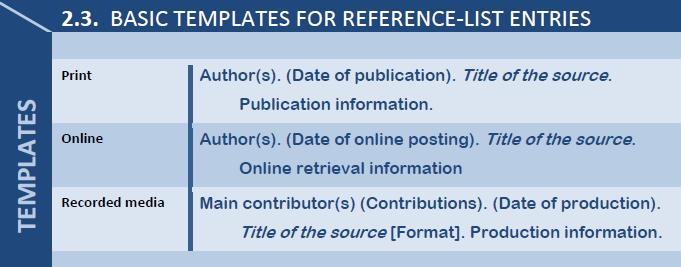- FSMHome
- Introduction
- 1. Research and Writing Responsibly
- 2. APA Documentation
- 3. APA Document Formatting
- 4. APA Conventions for Grammar and Mechanics
Send us an email
Templates for citation
All reference‐list entries include variations on the same basic elements, each of which reflects information useful for readers to access and review sources for themselves. However, these basic pieces are altered to accommodate the special features of particular kinds of sources. The following sections (2.3.1‐2.3.6) cover these variations, going from the most basic and traditional sources to more specialized and non‐traditional kinds of sources. To help you understand these variations, each section includes (a) an opening set of guidelines for dealing with particular kinds of sources, (b) templates reflecting standard structures for commonly used kinds of sources, and (c) many examples of reference‐list entries for real sources. Immediately below are the most basic templates for print, online, and recorded media (i.e., CDs, DVDs, etc.).

These three simple templates illustrate the most basic structures for all entries on the References page. Notice that each includes four parts: (a) author or main contributor; (b) date of publication; (c) title of the source; and (d) publication information. Notice also that each part begins with a capital letter and ends with a period (except for online retrieval info). The Basic Formatting Rules for Reference List Entries chart explains how to format further the information that goes into each element in the templates.
Note that you will need further instruction to learn extra details sometimes required for specialized and non‐traditional sources. As noted above, the subsections below arrange this added instruction according to the medium by which you accessed the source. Keep in mind, finally, that the templates and examples in the later subsections cannot possibly cover all the variations to the basic templates above, but they do provide guidance on the most commonly seen sources.
